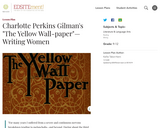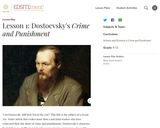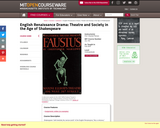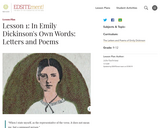
This unit walks students through a variety of activities revolving around George Orwell's book '1984'.
- Subject:
- English Language Arts
- Material Type:
- Unit of Study
- Provider:
- Michigan Virtual
- Author:
- Abby Perdok
- Date Added:
- 06/28/2017

This unit walks students through a variety of activities revolving around George Orwell's book '1984'.

Examines in detail the works of several American authors. Through close readings of poetry, novels, or plays, subject addresses such issues as literary influence, cultural diversity, and the writer's career. Topic: American Women Authors. This subject, crosslisted in Literature and Women's Studies, examines a range of American women authors from the seventeenth century to the present. It aims to introduce a number of literary genres and styles- the captivity narrative, slave novel, sensational, sentimental, realistic, and postmodern fiction- and also to address significant historical events in American women's history: Puritanism, the American Revolution, industrialization and urbanization in the nineteenth century, the Harlem Renaissance, World War II, the 60s civil rights movements. A primary focus will be themes studied and understood through the lens of gender: war, violence, and sexual exploitation (Keller, Rowlandson, Rowson); the relationship between women and religion (Rowlandson, Rowson, Stowe); labor, poverty, and working conditions for women (Fern, Davis, Wharton); captivity and slavery (Rowlandson, Jacobs); class struggle (Fern, Davis, Wharton, Larsen); race and identity (Keller, Jacobs, Larsen, Morrison); feminist revisions of history (Stowe, Morrison, Keller); and the myth of the fallen woman (take your pick). Essays and inclass reports will focus more particularly on specific writers and themes and will stress the skills of close reading, annotation, research, and uses of multimedia where appropriate. A classroom electronic archive has been developed for this course and will be available as a resource for images and other media materials.

This course studies the national literature of the United States since the early 19th century. It considers a range of texts - including, novels, essays, and poetry - and their efforts to define the notion of American identity. Readings usually include works by such authors as Nathaniel Hawthorne, Henry David Thoreau, Frederick Douglass, Emily Dickinson, and Toni Morrison.

This course explores the metaphorical, historical, social, and psychological value of ghosts in the American novel. Using the theme of "haunting" as a flashpoint for class discussion and a thematic center for our readerly attention, this course examines the American novel in the context of the various histories which might be said to haunt fictional characters in the American novel, to haunt the American novel itself, and ultimately to haunt us: America's colonial past, its slave past, and other memorable and painful chapters in its past.

This course covers works by major American novelists, beginning with the late 18th century and concluding with a contemporary novelist. The class places major emphasis on reading novels as literary texts, but attention is paid to historical, intellectual, and political contexts as well. The syllabus varies from term to term, but many of the following writers are represented: Rowson, Hawthorne, Melville, Twain, Wharton, James, and Toni Morrison. Previously taught topics include The American Revolution and Makeovers (i.e. adaptations and reinterpretation of novels traditionally considered as American "Classics"). May be repeated for credit with instructor's permission so long as the content differs.

The Art of the Probable" addresses the history of scientific ideas, in particular the emergence and development of mathematical probability. But it is neither meant to be a history of the exact sciences per se nor an annex to, say, the Course 6 curriculum in probability and statistics. Rather, our objective is to focus on the formal, thematic, and rhetorical features that imaginative literature shares with texts in the history of probability. These shared issues include (but are not limited to): the attempt to quantify or otherwise explain the presence of chance, risk, and contingency in everyday life; the deduction of causes for phenomena that are knowable only in their effects; and, above all, the question of what it means to think and act rationally in an uncertain world. Our course therefore aims to broaden students’ appreciation for and understanding of how literature interacts with--both reflecting upon and contributing to--the scientific understanding of the world. We are just as centrally committed to encouraging students to regard imaginative literature as a unique contribution to knowledge in its own right, and to see literary works of art as objects that demand and richly repay close critical analysis. It is our hope that the course will serve students well if they elect to pursue further work in Literature or other discipline in SHASS, and also enrich or complement their understanding of probability and statistics in other scientific and engineering subjects they elect to take.

Using the landmark feminist short story "The Yellow Wall-paper," students will employ close reading concepts to analyze setting, narrative style, symbol, and characterization.

This Composition Reader is an edited, curated collection of OER material for you to use as you see fit in your course. It consists of personal essays, literature, video and audio files, web writing, and long-form journalism.

Subject focuses on fiction, drama, and poetry and possibly films inspired by these topics mostly of the 1960s, 1970s, and 1980s. What is Britain now? Its metropolises are increasingly multicultural. Its hold over its distant colonies is a thing of the past. Its sway within the global political arena is weak. Its command over Northern Ireland, Wales, and Scotland is broken or threatened. What have novelists made of all this? What are they writing as the old empire fades away and as new social and political formations emerge? These are the questions that will concern us in this course.

Students examine the divided nature of Raskolnikov's character and personality. Then they uncover the divided natures of other characters"”a fact that becomes increasingly evident as the novel progresses to go beyond character analysis to comprehend Dostoyevsky's underlying themes. What does the novel imply about human nature? Dostoevsky clearly perceived that people are neither simple nor easily classified; they are often torn in opposite directions by forces both inside of and outside of themselves, sometimes with catastrophic results.

By closely reading historical documents and attempting to interpret them, students consider how Arthur Miller interpreted the facts of the Salem witch trials and how he successfully dramatized them in his play, "The Crucible." As they explore historical materials, such as the biographies of key players (the accused and the accusers) and transcripts of the Salem Witch trials themselves, students will be guided by aesthetic and dramatic concerns: In what ways do historical events lend themselves (or not) to dramatization? What makes a particular dramatization of history effective and memorable?

Intensive study of an important topic or period in drama. Close analysis of major plays, enriched by critical readings and attention to historical and theatrical contexts. Instruction and practice in oral and written communication. Topic for Fall: Renaissance Drama.

Learn how writer Zora Neale Hurston incorporated and transformed black folklife in her novel Their Eyes Were Watching God. By exploring Hurston's own life history and collection methods, listening to her WPA recordings of folksongs and folktales, and comparing transcribed folk narrative texts with the plot and themes of the novel, students will learn about the crucial role of oral folklore in Hurston's written work.

This collection uses primary sources to explore John Steinbeck's novel, The Grapes of Wrath. Digital Public Library of America Primary Source Sets are designed to help students develop their critical thinking skills and draw diverse material from libraries, archives, and museums across the United States. Each set includes an overview, ten to fifteen primary sources, links to related resources, and a teaching guide. These sets were created and reviewed by the teachers on the DPLA's Education Advisory Committee.

Reading Emily Dickinson's letters alongside her poems helps students to better appreciate a remarkable voice in American literature, grasp how Dickinson perceived herself and her poetry, and perhaps most relevant to their own endeavors consider the ways in which a writer constructs a "supposed person."

This lesson allow students to explore the forces that prompted the literary modernism movement, specifically focusing on modernist poetry. By allowing students to explore the movement independently, they will also be able to develop research and inquiry skills.

In this triumph of magical realism, One Hundred Years of Solitude chronicles a century of the remarkable BuendÃa family's history in the fictional Colombian town of Macondo. The three lessons presented here explore the fantastic elements of this imaginary world, the real history that lies behind them, and GarcÃa Márquez's own philosophical musings on writing about Latin America.

This lesson prompts students to think about a poem's speaker within the larger context of modernist poetry. First, students will review the role of the speaker in two poems of the Romanticism period before focusing on the differences in Wallace Stevens' modernist"Thirteen Ways of Looking at a Blackbird.

By studying other female characters in "The Awakening," students will see how Chopin carefully provides many examples of a socially acceptable "role" that Edna could adopt.

Students examine the novel's societal setting, which is also fraught with division. Crime and Punishment is more than just a demonstration of the idea that crime does not pay, it is a vivid depiction of societal injustice. For example, Dostoyevsky's mid-nineteenth century Russia offered women narrowly circumscribed roles, most often resulting in their dependence on men and/or a life of poverty. The negative effects of several other societal divisions raise additional questions.